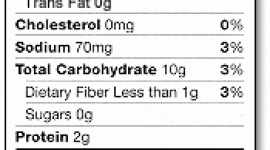Eating Disorders: Body Image and Advertising
 How does Today's Advertising Impact on Your Body Image?
How does Today's Advertising Impact on Your Body Image?
Advertisers often emphasize sexuality and the importance of physical attractiveness in an attempt to sell products,1 but researchers are concerned that this places undue pressure on women and men to focus on their appearance. In recent survey by Teen People magazine, 27% of the girls felt that the media pressures them to have a perfect body,2 and a poll conducted in 1996 by the international ad agency Saatchi and Saatchi found that ads made women fear being unattractive or old.3 Researchers suggest advertising media may adversely impact women's body image, which can lead to unhealthy behavior as women and girls strive for the ultra-thin body idealized by the media. Advertising images have also been recently accused of setting unrealistic ideals for males, and men and boys are beginning to risk their health to achieve the well-built media standard.
The Beautiful Message
The average woman sees 400 to 600 advertisements per day,4 and by the time she is 17 years old, she has received over 250,000 commercial messages through the media.5 Only 9% of commercials have a direct statement about beauty,6 but many more implicitly emphasize the importance of beauty--particularly those that target women and girls. One study of Saturday morning toy commercials found that 50% of commercials aimed at girls spoke about physical attractiveness, while none of the commercials aimed at boys referred to appearance.7 Other studies found 50% of advertisements in teen girl magazines and 56% of television commercials aimed at female viewers used beauty as a product appeal.8 This constant exposure to female-oriented advertisements may influence girls to become self-conscious about their bodies and to obsess over their physical appearance as a measure of their worth.9
A Thin Ideal
Advertisements emphasize thinness as a standard for female beauty, and the bodies idealized in the media are frequently atypical of normal, healthy women. In fact, today's fashion models weigh 23% less than the average female,10 and a young woman between the ages of 18-34 has a 7% chance of being as slim as a catwalk model and a 1% chance of being as thin as a supermodel.11 However, 69% of girls in one study said that magazine models influence their idea of the perfect body shape,12 and the pervasive acceptance of this unrealistic body type creates an impractical standard for the majority of women.
Some researchers believe that advertisers purposely normalize unrealistically thin bodies, in order to create an unattainable desire that can drive product consumption.13 "The media markets desire. And by reproducing ideals that are absurdly out of line with what real bodies really do look like...the media perpetuates a market for frustration and disappointment. Its customers will never disappear," writes Paul Hamburg, an assistant professor of Psychiatry at Harvard Medical School.14 Considering that the diet industry alone generates $33 billion in revenue,15 advertisers have been successful with their marketing strategy.
Advertising's Impact
Women frequently compare their bodies to those they see around them, and researchers have found that exposure to idealized body images lowers women's satisfaction with their own attractiveness.16 One study found that people who were shown slides of thin models had lower self-evaluations than people who had seen average and oversized models,17 and girls reported in a Body Image Survey that "very thin" models made them feel insecure about themselves.18 In a sample of Stanford undergraduate and graduate students, 68% felt worse about their own appearance after looking through women's magazines.19 Many health professionals are also concerned by the prevalence of distorted body image among women, which may be fostered by their constant self-comparison to extremely thin figures promoted in the media. Seventy-five percent (75%) of "normal" weight women think they are overweight20 and 90% of women overestimate their body size.21
Dissatisfaction with their bodies causes many women and girls to strive for the thin ideal. The number one wish for girls ages 11 to 17 is to be thinner,22 and girls as young as five have expressed fears of getting fat.23 Eighty percent (80%) of 10-year-old girls have dieted,24 and at any one time, 50% of American women are currently dieting.25 Some researchers suggest depicting thin models may lead girls into unhealthy weight-control habits,26 because the ideal they seek to emulate is unattainable for many and unhealthy for most. One study found that 47% of the girls were influenced by magazine pictures to want to lose weight, but only 29% were actually overweight.27 Research has also found that stringent dieting to achieve an ideal figure can play a key role in triggering eating disorders.28 Other researchers believe depicting thin models appears not to have long-term negative effects on most adolescent women, but they do agree it affects girls who already have body-image problems.29 Girls who were already dissatisfied with their bodies showed more dieting, anxiety, and bulimic symptoms after prolonged exposure to fashion and advertising images in a teen girl magazine.30 Studies also show that a third of American women in their teens and twenties begin smoking cigarettes in order to help control their appetite.31
Boys and Body Image
Although distorted body image has widely been known to affect women and girls, there is growing awareness regarding the pressure men and boys are under to appear muscular. Many males are becoming insecure about their physical appearance as advertising and other media images raise the standard and idealize well-built men. Researchers are concerned about how this impacts men and boys, and have seen an alarming increase in obsessive weight training and the use of anabolic steroids and dietary supplements that promise bigger muscles or more stamina for lifting.32 One study suggests that an alarming trend in toy action figures' increasing muscularity is setting unrealistic ideals for boys much in the same way Barbie dolls have been accused of giving an unrealistic ideal of thinness for girls.33 "Our society's worship of muscularity may cause increasing numbers of men to develop pathological shame about their bodies... Our observations of these little plastic toys have stimulated us to explore further links between cultural messages, body image disorders and use of steroids and other drugs," says researcher Dr. Harrison Pope.34
The majority of teenagers with eating disorders are girls (90%),35 but experts believe the number of boys affected is increasing and that many cases may not be reported, since males are reluctant to acknowledge any illness primarily associated with females.36 Studies have also found that boys, like girls, may turn to smoking to help them lose weight. Boys ages 9 to 14 who thought they were overweight were 65% more likely to think about or try smoking than their peers, and boys who worked out every day in order to lose weight were twice as likely to experiment with tobacco.37
Source: Body Image and Advertising . 2000. Issue Briefs. Studio City, Calif.: Mediascope Press. Last revision was April 25, 2000.
Body Image and Advertising Article References:
- Fox, R.F. (1996). Harvesting Minds: How TV Commercials Control Kids . Praeger Publishing: Westport, Connecticut.
- "How to love the way you look." Teen People , October, 1999.
- Peacock, M. (1998). "Sex, Housework & Ads." Women's Wire web site. (Online: http://womenswire.com/forums/image/D1022/. Last retrieved April 14, 2000]
- Dittrich, L. "About-Face facts on the MEDIA." About-Face web site. [Online: http://about-face.org/r/facts/media.shtml. Last retrieved April 14, 2000]
- Media Influence on Teens. Facts compiled by Allison LaVoie. The Green Ladies Web Site. [online: http://kidsnrg.simplenet.com/grit.dev/london/g2_jan12/green_ladies/media/ . Last accessed April 13, 2000]
- Dittrich, L. "About-Face facts on the MEDIA," op. cit.
- Media's Effects on Girls: Body Image and Gender Identity, Fact Sheet.
- Ibid.
- Dittrick, L. "About-Face facts on BODY IMAGE." About-Face web site. [Online: http://about-face.org/r/facts/bi.shtml . Last retrieved April 14, 2000]
- "Facts on Body and Image," compiled by Jean Holzgang. Just Think Foundation web site. [Online: http://www.justthink.org/bipfact.html . Last retrieved April 14, 2000]
- Olds, T. (1999). "Barbie figure 'life-threatening'." The Body Culture Conference. VicHealth and Body Image & Health Inc.
- "Magazine Models Impact Girls' Desire to Lose Weight, Press Release." (1999). American Academy of Pediatrics.
- Hamburg, P. (1998). "The media and eating disorders: who is most vulnerable?" Public Forum: Culture, Media and Eating Disorders, Harvard Medical School.
- Ibid.
- Schneider, K. "Mission Impossible." People Magazine , June, 1996.
- Dittrich, L. "About-Face facts on the MEDIA," op. cit.
- Ibid.
- Maynard, C. (1998). "Body Image." Current Health 2 .
- Dittrich, L. "About-Face facts on the MEDIA," op. cit.
- Kilbourne, J., "Slim Hopes," video, Media Education Foundation, 1995.
- Media Influence on Teens, op. cit.
- "Facts on Body and Image," op. cit.
- Media Influence on Teens, op. cit.
- Kilbourne, J., op. cit.
- Schneider, K., op. cit.
- Woznicki, K. (1999). "Pop Culture Hurts Body Image." OnHealth web site. [Online: http://www.onhealth.com/ch1/briefs/item,55572.asp . Last retrieved April 13, 2000]
- "Magazine Models Impact Girls' Desire to Lose Weight, Press Release," op. cit.
- "Facts on Body and Image," op. cit.
- Goode, E. "Girls' Self Image Survives Effect of Glossy Ads." The New York Times , August 24, 1999.
- Ibid.
- Morris, L. "The Cigarette Diet." Allure , March 2000.
- Shallek-Klein, J. "Striving for the Baywatch Boy Build." Silver Chips Newspaper, October 7, 1999.
- "Body Image Disorder Linked to Toy Action Figures' Growing Muscularity," Press Release..(1999). McLean Hopital.
- Ibid.
- Schneider, K., op. cit.
- Wax. R.G. (1998). "Boys and Body Image." San Diego Parent Magazine.
- Marcus, A. (1999). "Body Image Tied to Smoking in Kids." Health Scout. Merck-Medco Managed Care.
next: Many Great Women Have Been Plagued by Depression and Body Image Disorders
~ eating disorders library
~ all articles on eating disorders
APA Reference
Staff, H.
(2008, December 11). Eating Disorders: Body Image and Advertising, HealthyPlace. Retrieved
on 2025, December 15 from https://www.healthyplace.com/eating-disorders/articles/eating-disorders-body-image-and-advertising



